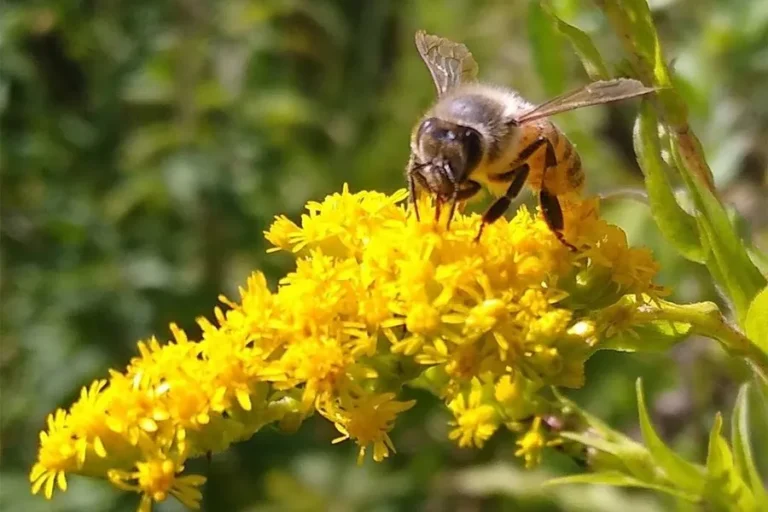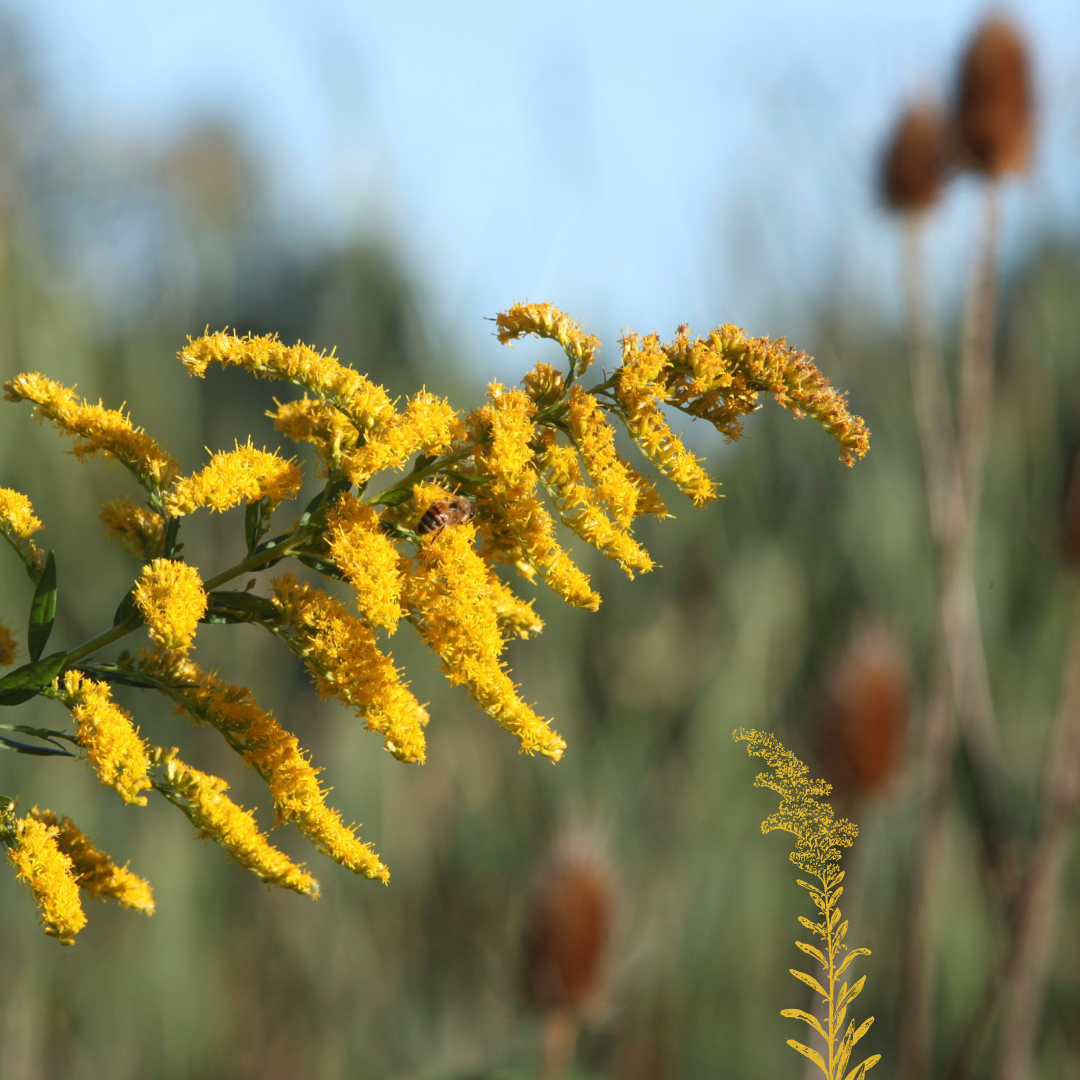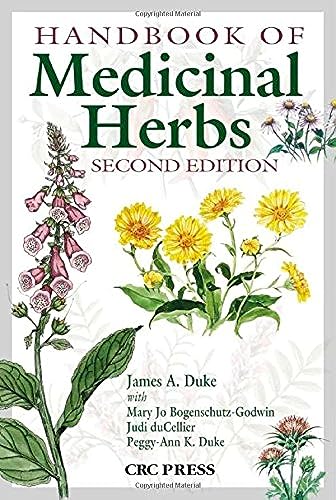I have allowed a large stand of goldenrod to thrive at the back of my property. Because it blooms when most of the other things growing in my garden have withered and died, I call Goldenrod the Queen of My Autumn Garden. For me, the fact that it makes a beautiful show is enough, but over the past year, my blog posts about the healing properties of goldenrod have been read over 1,000 times. It is not my followers who read those posts. People who search Google find my posts about goldenrod.. From that fact, I deduce that the public is interested in goldenrod and how to harness this gift from nature.
Native Plant
In many parts of the USA, goldenrod is a native plant. Speaking generally, native plants have adapted to an area’s climate and soil and have survived in that space–perhaps forever. In the USA, our indigenous people used our native plants as healers. In the USA, the native goldenrod is solidago.
“Its botanical name, Solidago, is Latin for solidus, meaning ‘to make whole.’ This refers to the plant’s healing and medicinal properties. It has been used to heal wounds of the skin and to treat inflammation of the mouth and throat, tuberculosis, diabetes, and arthritis. It has diuretic and anti-inflammatory properties. Native Americans have used its leaves as a poultice for bee stings and have made tea with its flowers and leaves to reduce fever. During the American Revolution, goldenrod tea was made as a substitute for British tea.” Penn State Extension

Honey bee on goldenrod by Denise D’Aurora, Penn State Master Gardener
Goldenrod Is A Pollinator Plant
The area in my garden where my goldenrod is allowed to grow undisturbed is part of my pollinator garden. Goldenrod attracts honeybees and other insects. The migrating monarchs depend on the nectar of goldenrod, as they journey southward. While I have bought several other native plant to help restore my pollinator garden, goldenrod grown in my yard prolifically. If I were forced to buy the hundreds of goldenrod plants that I have growing naturally. the cost would be in the thousands.
Along with Poke Berries. Goldenrod has strong dying properties. We’ve reached the time of year when we can paint with poke berry juice and dye fabrics with goldenrod blossoms.
Healing Properties of Goldenrod
Handbook of Medicinal Herbs 339 —
“Allergenic (1; CRC); Analgesic (1; APA); Antiedemic (1; HH2); Antiexudative (1; HH2); Antiinflammatory (2; APA; KOM; SHT); Antilithic (1; PH2); Antipyretic (f; CRC; PIP); Antiseptic (1; PNC); Antispasmodic (1; APA; EFS; KOM; PIP); Antitumor (1; APA); Aquaretic (1; BGB; SHT); Astringent (1; CRC; EFS); Candidicide (1; BGB; PNC); Carminative (f; CRC; HH2; PNC; WOI); Cicatrizant (f; WOI); Decoagulant (f; CRC); Diaphoretic (f; CRC; PNC); Digestive (f; CRC; EFS); Diuretic (2; APA; KOM; MAD; PIP); Expectorant (f; CRC; EFS); Fungicide (1; APA; BGB; HH2); Hemostat (1; CRC; HHB); Hypotensive (1; PNC); Immunostimulant (1; APA); Laxative (f; APA); Litholytic (1; CRC; MAD); Nervine (f; CRC); Sedative (1; APA); Spermicide (1; APA; BGB); Stimulant (f; CRC); Tonic (f; CRC); Urinary Antiseptic (f; MAD); Vulnerary (1; APA; BGB; WOI). Indications (Goldenrod) — Albuminuria (f; CRC; MAD); Amenorrhea (f; CRC); Arthrosis (f; APA; CRC; MAD); Asthma (f; CRC; MAD; PH2); Atony (f; CEB); Bladder Stone (2; APA; CRC; PHR; PH2); Bleeding (1; CRC; HHB; PH2); BPH (f; CRC; HHB; PHR; PH2); Bronchosis (f; PH2); Calculus (2; BGB); Cancer (1; APA); Cancer, breast (f; CRC); Candida (1; BGB; HH2; PNC); Catarrh (1; BGB); Cholecystosis (f; CRC); Cholera (f; CRC); Constipation (f; APA); Cramp (1; APA; EFS; KOM; PIP); Cystosis (1; CRC; HHB; PH2); Diabetes (f; HH2; PHR; PH2); Diarrhea (1; CEB; CRC; WOI); Diphtheria (f; CRC); Dropsy (f; CRC; MAD); Dysentery (1; CRC; MAD; WOI); Dysmenorrhea (f; CRC); Dysuria (f; CRC; MAD); Eczema (f; APA; CRC; HH2; MAD); Edema (1; CRC; HH2); Fever (f; CRC; PIP; PNC; WOI); Flu (f; CRC); Fungus (1; APA; BGB; HH2); Gas (f; CRC; HH2; PNC; WOI); Gastrosis (f; CRC); Gout (f; CRC; MAD; PHR; PH2); Gravel (2; CRC; KOM; PIP); Headache (f; CRC); Hemorrhoid (f; MAD; PHR); Hepatomegaly (f; PHR); Hepatosis (f; PH2); High Blood Pressure (1; PNC); Immunodepression (1; APA); Infection (1; APA; BGB; HH2; PHR; PH2); Inflammation (2; APA; KOM; PH2; SHT); Insomnia (1; APA); Kidney Stone (2; APA; CRC; PHR; PH2); Malaria (f; CRC); Mastosis (f; JLH); Measles (f; CRC); Menorrhagia (f; HHB); Mycosis (1; APA; BGB; HH2); Nephrosis (1; APA; CRC; KOM; MAD; PH2); Nervousness (1; APA); Pain (1; APA); Pertussis (1; CRC; MAD); Pharyngosis (1; APA; PHR; PH2); Phosphaturia (f; MAD); Phthisis (f; MAD); Pulmonosis (f; PH2); Rheumatism (f; APA; CRC; PHR; PH2); Scrofula (f; HH2; MAD); Sore (f; WOI); Sore Throat (1; CRC; PH2); Spasm (f; CRC); Splenosis (f; MAD); Stomatosis (1; APA; PHR; PH2); Stone (2; CRC; KOM; MAD; PH2; SHT); Swelling (1; HH2); Tenesmus (f; MAD); Toothache (f; MAD; HHB); Tuberculosis (f; MAD; PHR; PH2); Tumor (1; APA); Uremia (f; CRC; MAD); UTI (2; APA; KOM; PH2; SHT); Water Retention (2; APA; FNF; KOM; MAD; PIP); Wound (1; APA; MAD; PHR; PH2; WOI); Yeast (1; BGB; HH2; PNC). Dosages (Goldenrod) — 6–15 g herb (APA); 3–5 g herb/240 ml up to several ×/day (APA); 15–20 g herb (MAD); 6–12 g crude herb (PIP; SHT);
Dosage
“1–2 tsp (3–5 g) per 150 ml hot water, 2–4 ×/day between meals (PH2); 2–4 ml liquid leaf extract (PNC).
“Contraindications, Interactions, and Side Effects (Goldenrod) — Class 2d. Patients with chronic nephropathy should consult a practitioner before taking (AHP).“Hazards and/or side effects not known for proper therapeutic dosages” (PH2).
“Contraindications for the herb: patients with chronic renal disease should first consult a physician.” Handbooks of Medicinal Herbs
“Aaron’s rod; European goldenrod; Solidago canadensis; Solidago virgaurea
Goldenrod Does Not Make You Sneeze – Ragweed Makes You Sneeze
“Goldenrod is often blamed for seasonal allergies. Actually it is another plant, ragweed, which blooms at the same time, that is usually responsible.
Plant Description
“Goldenrod can crossbreed with other plants. As a result, there are at least 130 species of goldenrod in the United States alone.” Mount Sinai
Discover more from Jacki Kellum
Subscribe to get the latest posts sent to your email.

